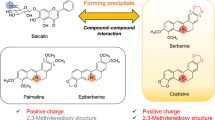Abstract
Dihydroasparagusic acid is the first naturally occurring dimercaptanic compound that was isolated in 1948 from Asparagus concentrate. Although several synthetic procedures were proposed in the past decades for this natural substance, most of its chemical properties remain unstudied. In this work the capacity of the acid to act as an antidote against mercury(II) toxicity was evaluated in a simple biological model system, Saccharomyces cerevisiae, and is explained by the formation of a precipitate between mercury(II) and dihydroasparagusic acid. The precipitate was analyzed and studied. The solubility was determined by measuring in equilibrated solutions either the concentration of the total mercury(II) present in solution or the free concentration of hydrogen ions. The protonation constants were determined at 25 °C and in 1.00 M NaCl, as constant ionic medium, by means of potential difference measurements of a galvanic cell with a glass electrode. The experimental data are explained by proposing the chemical composition of the precipitate and the value of its solubility product. As the solubility of the precipitate increases by increasing the concentration of dihydroasparagusic acid, the further formation of a complex between mercury(II) and dihydroasparagusic acid is assumed.
Graphical abstract





Similar content being viewed by others
References
Jansen EF (1948) J Biol Chem 176:657
Casas JS, Jones MM (1980) J Inorg Nucl Chem 42:99
Coates RL, Jones M (1978) J Inorg Nucl Chem 39:677
Lenz GR, Martell AE (1964) Biochemistry 3:745
Van der Linden WE, Beers C (1974) Anal Chim Acta 68:143
Kuchinskas EJ, Rosen Y (1962) Arch Biochem Biophys 97:370
Sugiura Y, Yokoyama A, Tanaka H (1970) Chem Pharm Bull 18:693
Bottari E, Festa MR (1997) Talanta 44:1705
Apruzzese F, Bottari E, Festa MR (2002) Talanta 56:459
Apruzzese F, Bottari E, Festa MR (2003) J Sol Chem 32:65
Apruzzese F, Bottari E, Festa MR (2004) Ann Chim (Rome) 94:45
Basinger MM, Casas JS, Jones MM, Weaver AD, Weinstein NH (1981) J Inorg Nucl Chem 43:1419
Peters RA, Stocken LA, Thompson RHS (1945) Nature 156:616
Venditti A, Mandrone M, Serrilli AM, Bianco A, Iannello C, Antognoni F, Poli F (2013) J Agric Food Chem 61:6848
Biedermann G, Sillèn LG (1953) Ark Kemi 5:425
Sillèn LG (1956) Acta Chem Scand 10:186
Bottari E, Coccitto T, Curzio G, Festa MR, Jasionowska R (1988) Ann Chim (Rome) 78:635
Di Stefano C, Mineo P, Rigano C, Sammartano S (1993) Ann Chim (Rome) 83:343
Ciavatta L, Grimaldi M (1968) J Inorg Nucl Chem 30:197
Rossotti F, Whewell R (1977) J Chem Soc Dalton Trans Inorg Chem (12):1223
Ciavatta L, Grimaldi M (1968) J Inorg Nucl Chem 30:563
Yanagawa H, Kato T, Sagami H, Kitahara Y (1973) Synthesis 10:607
Schotte L, Ström H (1956) Acta Chem Scand 10:687
Singh R, Whitesides GM (1990) J Am Chem Soc 112:1190
Zervas L, Photarki I, Ghelis N (1963) J Am Chem Soc 85:1337
Venditti A, Serrilli AM, Campanella L, Bianco A (2010) In: Proceedings of the 24th international symposium on organic chemistry of sulfur (ISOCS-24), Firenze, 25–30 July 2010
Schwarzenbach G, Flaschka H (1965) Die Komplexometrische titration. Ferdinand Enke Verlag, Stuttgart
Brown AS (1934) J Am Chem Soc 56:646
Author information
Authors and Affiliations
Corresponding author
Electronic supplementary material
Below is the link to the electronic supplementary material.
Rights and permissions
About this article
Cite this article
Bianco, A., Bottari, E., Festa, M.R. et al. Properties of dihydroasparagusic acid and its use as an antidote against mercury(II) poisoning. Monatsh Chem 144, 1767–1773 (2013). https://doi.org/10.1007/s00706-013-1095-3
Received:
Accepted:
Published:
Issue Date:
DOI: https://doi.org/10.1007/s00706-013-1095-3




